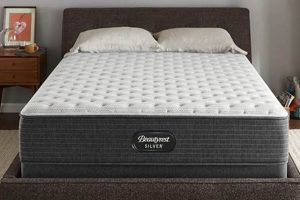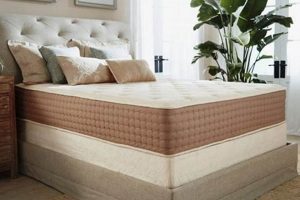A sleeping surface addition designed to enhance comfort and minimize exposure to potentially harmful substances is a growing consumer priority. These products aim to provide a healthier sleep environment by utilizing materials that are free from known toxins, such as volatile organic compounds (VOCs), flame retardants, and certain chemicals often found in conventional bedding. As an example, a latex mattress topper certified by a reputable third-party organization is crafted to ensure it meets specific standards for material safety and emissions.
The rising demand stems from increased awareness of the potential health implications associated with prolonged exposure to chemicals released from bedding materials. Benefits include reduced risk of respiratory irritation, allergic reactions, and other sensitivities. Historically, concerns regarding mattress flammability led to the widespread use of chemical flame retardants. However, growing evidence of their potential toxicity has driven the shift towards safer alternatives, such as natural fire barriers like wool.
This article will delve into the crucial factors to consider when selecting a healthier bedding option, examining various material options, certifications to look for, and key features that contribute to a comfortable and safe sleep experience. The subsequent sections provide a comprehensive guide to making informed decisions in this product category.
Guidance on Acquiring a Healthier Mattress Overlay
The following recommendations are designed to assist in the selection process, ensuring the chosen product minimizes exposure to potentially harmful substances and promotes a healthier sleep environment.
Tip 1: Prioritize Certified Materials: Seek out certifications from reputable organizations, such as GOLS (Global Organic Latex Standard) for latex, GOTS (Global Organic Textile Standard) for cotton or wool, and CertiPUR-US for polyurethane foam. These certifications verify that materials meet specific standards for chemical emissions, material content, and manufacturing processes.
Tip 2: Investigate Material Composition: Scrutinize the ingredient list to identify potential allergens or irritants. Common materials include natural latex, organic cotton, wool, and plant-based foams. Avoid overlays containing polyurethane foam without proper certification or those listing undisclosed chemical additives.
Tip 3: Consider Natural Fire Retardants: Opt for options utilizing natural fire barriers such as wool, which is inherently flame-resistant. Avoid those treated with chemical flame retardants like PBDEs (polybrominated diphenyl ethers), known to be potentially harmful.
Tip 4: Assess VOC Emissions: Low VOC (Volatile Organic Compound) emissions are crucial for indoor air quality. Look for products that have been tested and certified for low VOC emissions, such as those meeting GREENGUARD Gold standards.
Tip 5: Evaluate Density and Support: Density influences the overlay’s durability and support. Higher density materials tend to provide better pressure relief and last longer. Match the density and thickness to individual sleep preferences and body weight.
Tip 6: Research Manufacturing Practices: Inquire about the manufacturer’s commitment to sustainable and ethical production practices. Environmentally conscious practices often correlate with a greater emphasis on material safety.
Tip 7: Review Return Policies and Warranties: A generous return policy allows for a trial period to assess comfort and suitability. A comprehensive warranty indicates the manufacturer’s confidence in the product’s longevity and quality.
Adherence to these guidelines contributes to a more informed decision, resulting in a sleeping surface that minimizes chemical exposure and promotes overall well-being.
The subsequent section explores specific material considerations to aid in navigating the diverse product landscape.
1. Material Composition
Material composition is paramount when considering a sleeping surface overlay designed to minimize exposure to potentially harmful substances. The constituent materials directly determine the levels of volatile organic compounds (VOCs) released, the presence of allergenic substances, and the potential for exposure to chemical flame retardants. For instance, a topper constructed of conventional polyurethane foam, without proper certification, may off-gas VOCs, potentially leading to respiratory irritation or other adverse health effects. Conversely, a topper composed of certified organic latex or cotton offers a substantially reduced risk of chemical exposure.
The selection of materials extends beyond just minimizing harm; it also influences the overall healthfulness of the sleep environment. Natural materials like wool, in addition to being inherently flame-resistant, possess moisture-wicking properties that contribute to temperature regulation and reduced microbial growth. A topper with synthetic materials and chemical treatments could disrupt these beneficial properties. Furthermore, the sourcing and processing of materials impact environmental sustainability, with organically grown and sustainably harvested options representing a responsible choice.
Therefore, thorough examination of material composition is crucial in the pursuit of a healthier sleep surface. Consumers must prioritize certified materials, scrutinize ingredient lists, and understand the potential implications of material choices on both personal health and environmental sustainability. Selecting a topper with transparent and verifiable material information is a fundamental step toward achieving a sleep environment free from harmful chemicals.
2. Certification Standards
The concept of a sleeping surface overlay devoid of harmful chemicals relies heavily on adherence to established certification standards. These standards provide a framework for evaluating and verifying the material composition and emissions of bedding products. Their importance stems from the consumer’s inherent inability to independently assess the chemical safety of a complex manufactured item. Without third-party validation, claims of non-toxicity lack verifiable substantiation. For example, a mattress overlay bearing the GOLS (Global Organic Latex Standard) certification ensures that the latex used originates from organically managed plantations and meets stringent chemical emission limits throughout the manufacturing process. The absence of such certification renders the “non-toxic” designation questionable, as potentially harmful chemicals may be present despite marketing assertions.
Different certification bodies address varying aspects of product safety. CertiPUR-US certification, for instance, focuses on the polyurethane foam used in some overlays, verifying that it is made without ozone depleters, ce
rtain flame retardants, and heavy metals, and that it has low VOC emissions. GOTS (Global Organic Textile Standard) covers textiles, ensuring that cotton or wool components are organically produced and processed according to environmentally and socially responsible criteria. GREENGUARD Gold certification examines overall chemical emissions, ensuring that products meet rigorous standards for indoor air quality. The practical significance of understanding these distinctions lies in selecting certifications relevant to the specific materials used in the overlay and the potential hazards they pose. Consumers can verify the validity of certifications by cross-referencing with the certifying organization’s online database.
In summary, certification standards are integral to the realization of a sleeping surface overlay free from harmful chemicals. They serve as an objective benchmark, providing assurance that a product has been independently tested and verified to meet specific safety criteria. Challenges remain in harmonizing standards and increasing consumer awareness, but a thorough understanding of available certifications remains a critical tool for making informed purchasing decisions and securing a healthier sleep environment. Without credible certification, claims of non-toxicity remain unsubstantiated, leaving consumers vulnerable to potential chemical exposure.
3. VOC Emissions
Volatile Organic Compound (VOC) emissions represent a critical consideration in evaluating the safety and suitability of any sleeping surface overlay designed to minimize exposure to potentially harmful substances. The off-gassing of VOCs from bedding materials directly impacts indoor air quality and poses potential health risks. Therefore, minimizing VOC emissions is paramount when selecting a “best non toxic mattress topper”.
- Sources of VOCs in Mattress Toppers
VOCs can originate from various components used in manufacturing mattress toppers, including polyurethane foam, adhesives, dyes, and flame retardants. Synthetic latex and conventional cotton, if not processed according to strict environmental standards, can also contribute to VOC emissions. The specific types of VOCs released vary depending on the materials and manufacturing processes involved, but common examples include formaldehyde, benzene, toluene, and methylene chloride.
- Health Impacts of VOC Exposure
Exposure to VOCs can trigger a range of adverse health effects, particularly in sensitive individuals. Short-term exposure may cause respiratory irritation, headaches, nausea, and dizziness. Prolonged or repeated exposure to high levels of VOCs can contribute to more serious health problems, including damage to the liver, kidneys, and central nervous system. Children, pregnant women, and individuals with pre-existing respiratory conditions are particularly vulnerable to the effects of VOC exposure.
- Certification Standards for VOC Emissions
Several certification standards address VOC emissions in bedding products. GREENGUARD Gold certification, for example, sets stringent limits on VOC emissions for products used in indoor environments, including schools and healthcare facilities. Oeko-Tex Standard 100 certification tests for a wide range of harmful substances, including VOCs, and ensures that products meet specific safety criteria. Selecting mattress toppers certified by these organizations provides assurance that the product has been independently tested and verified to have low VOC emissions.
- Strategies for Minimizing VOC Exposure
Beyond selecting certified products, several strategies can further reduce VOC exposure from mattress toppers. Airing out the topper in a well-ventilated area for several days before use allows for initial off-gassing to occur. Using a mattress protector made of natural materials, such as organic cotton or wool, can create a barrier between the topper and the sleeper, reducing direct exposure. Maintaining good indoor ventilation by opening windows and using air purifiers can also help to lower VOC concentrations in the bedroom.
In conclusion, VOC emissions represent a significant factor in evaluating the safety and suitability of mattress toppers claiming to be non-toxic. By understanding the sources and health impacts of VOCs, seeking out certified products, and implementing strategies to minimize exposure, consumers can make informed decisions that promote a healthier sleep environment. The careful consideration of VOC emissions is thus essential in the pursuit of a “best non toxic mattress topper”.
4. Flame Retardants
The presence, or absence, of flame retardants is a defining characteristic differentiating conventional mattress toppers from those marketed as a healthier, non-toxic alternative. Historically, the inclusion of chemical flame retardants in bedding was mandated to meet flammability standards. However, increasing evidence suggests potential adverse health effects associated with exposure to certain classes of these chemicals, including polybrominated diphenyl ethers (PBDEs), chlorinated Tris, and organophosphates. The concern arises from the fact that these substances can leach out of the mattress topper over time, leading to inhalation, ingestion, or dermal absorption. The resultant impact is a compromised sleep environment, counteracting the objective of a “best non toxic mattress topper”.
The selection of a mattress topper devoid of harmful flame retardants necessitates careful scrutiny of product labeling and material composition. Alternative approaches to meeting flammability standards exist, employing materials with inherent fire-resistant properties, such as wool or inherently flame-resistant rayon derived from wood pulp. These natural barriers offer a safer alternative, eliminating the need for potentially hazardous chemicals. A real-life example of the consequences of inadequate regulatory oversight is the historical prevalence of PBDEs in bedding, which were later phased out due to health concerns. Consumers can identify safer options by seeking certifications like GOTS (Global Organic Textile Standard) or OEKO-TEX Standard 100, which restrict or prohibit the use of specific flame retardants. The practical significance lies in minimizing potential long-term health risks associated with exposure to these chemicals, contributing to an overall healthier indoor environment.
In summary, the relationship between flame retardants and non-toxic mattress toppers is one of direct opposition. The quest for a “best non toxic mattress topper” necessitates a conscious avoidance of bedding incorporating chemical flame retardants, prioritizing instead those utilizing inherently fire-resistant materials. While challenges remain in ensuring complete transparency in product labeling and achieving uniform safety standards across the industry, the understanding of alternative fire safety measures is paramount for making informed purchasing decisions and prioritizing health. The ongoing evolution of material science and regulatory frameworks presents a continuous opportunity to refine and improve the safety of bedding products, ultimately leading to more effective and verifiable non-toxic options.
5. Density & Support
The correlation between density, support, and the criteria for a “best non toxic mattress topper” is crucial. Density dictates the material’s capacity to evenly distribute weight and resist compression, while support refers to the topper’s ability to maintain spinal alignment. Both factors influence not only comfort but also the longevity and potential health implications of the product.
- Material Density and Chemical Stability
Higher density in materials like latex or memory foam can correlate with increased material stability and reduced off-gassing of volatile organic compounds (VOCs). A denser structure minimizes the breakdown of materials over time, thereby reducing the release of potentially harmful chemicals into the sleep environment. Conversely, low-density foams may degrade more rapidly, leading to increased VOC emissions and diminished support, thus compromising the non-toxic aspect of the topper.
- Support and Pressure Point Relief
Adequate support is essential for maintaining proper spinal alignment and reducing pressure points during sleep. A topper that lacks sufficient density or firmness can lead to uneven weight distribution, resulting in discomfort and potential musculoskeletal issues. Selecting a topper with appropriate density and firmness, based on individual body weight and sleep preferences, is critical for promoting a healthy and restorative sleep posture. The optimal balance ensures that the topper conforms to the body’s contours without excessive sinking, which could compromise spinal alignment.
- Density, Support, and Material Certification
Material certifications such as CertiPUR-US or GOLS often include criteria related to density and performance testing. These certifications verify that the materials used meet minimum standards for durability and support, in addition to chemical emissions. Therefore, selecting a certified topper that also offers adequate density and support provides a greater assurance of both comfort and safety. The certification process helps to validate claims made by manufacturers regarding the long-term performance and chemical stability of their products.
- Long-Term Performance and Material Degradation
The relationship between density, support, and material degradation is significant. Over time, low-density materials are prone to compression and loss of support, resulting in uneven sleep surfaces and potential exposure to degraded materials. A high-density topper, made with durable and chemically stable materials, will maintain its shape and supportive properties for a longer period, ensuring a consistent and healthier sleep environment. This long-term performance is a key indicator of the value and safety of a “best non toxic mattress topper”.
The interplay of density and support directly impacts the efficacy of a mattress topper in promoting a healthy sleep environment. A topper that effectively balances these attributes, using certified and durable materials, contributes to reduced chemical exposure, proper spinal alignment, and long-term performance, aligning with the core principles of selecting a “best non toxic mattress topper”. The careful consideration of density and support, in conjunction with material composition and certification, is crucial for achieving a sleep surface that is both comfortable and safe.
6. Manufacturing Practices
The manufacturing processes employed in the production of a mattress topper exert a significant influence on its overall toxicity and suitability as a healthy sleep surface. From raw material sourcing to final assembly and packaging, each step presents opportunities for the introduction or elimination of potentially harmful substances. Therefore, understanding the implications of manufacturing practices is essential when evaluating claims of a “best non toxic mattress topper”.
- Raw Material Sourcing and Processing
The origin and processing methods of raw materials such as latex, cotton, and wool directly impact the presence of pesticides, herbicides, and other contaminants. For instance, conventionally grown cotton may be treated with harsh chemicals during cultivation and processing, potentially leaving residues in the final product. Organic farming practices and environmentally conscious processing methods, such as mechanical harvesting and natural dyes, minimize these risks. Selecting a mattress topper made with certified organic or sustainably sourced materials demonstrates a commitment to reducing chemical exposure from the outset.
- Chemical Usage and Waste Management
The types and quantities of chemicals used during manufacturing, including adhesives, solvents, and cleaning agents, significantly affect the final product’s VOC emissions and overall toxicity. Manufacturing facilities that prioritize closed-loop systems, minimize chemical usage, and implement robust waste management protocols reduce the likelihood of harmful substances being incorporated into the mattress topper. For example, water-based adhesives and low-VOC cleaning agents offer safer alternatives to traditional chemical-based products. The proper disposal and treatment of chemical waste prevent environmental contamination and protect worker health.
- Factory Conditions and Worker Safety
Safe and ethical labor practices within the manufacturing facility are indicative of a commitment to responsible production. Working conditions that prioritize worker health and safety minimize the risk of chemical exposure for employees and ensure the proper handling of materials. Factories that adhere to fair labor standards and provide adequate ventilation, personal protective equipment, and training demonstrate a commitment to creating a safe and healthy working environment. These practices often correlate with a greater emphasis on product safety and quality.
- Transportation and Packaging
The transportation and packaging methods employed can also contribute to the overall toxicity of a mattress topper. The use of chemical fumigants during shipping to prevent pest infestations can introduce harmful substances. Similarly, packaging materials made from recycled plastics or treated with chemical coatings may release VOCs. Choosing a mattress topper that is transported without fumigation and packaged in eco-friendly materials, such as recycled cardboard or plant-based films, further minimizes potential chemical exposure.
These various aspects of manufacturing processes collectively determine the chemical footprint of a mattress topper. Selecting a product from a manufacturer that prioritizes sustainable and ethical practices, minimizes chemical usage, and ensures safe working conditions contributes to a healthier and more environmentally responsible sleep environment. By considering these factors, consumers can make informed choices and support companies that are committed to producing a truly “best non toxic mattress topper”.
Frequently Asked Questions
The subsequent questions and answers address common concerns and misconceptions regarding sleeping surface overlays designed to minimize exposure to harmful substances. This information aims to provide clarity and support informed decision-making.
Question 1: Are all mattress toppers labeled “non-toxic” truly free of harmful chemicals?
The term “non-toxic” lacks a universally regulated definition. Products labeled as such should be accompanied by verifiable third-party certifications, such as GOTS, GOLS, or Cert
iPUR-US, to substantiate claims regarding chemical content and emissions. The absence of credible certification raises concerns regarding the accuracy of the “non-toxic” designation.
Question 2: What are the most common harmful chemicals found in conventional mattress toppers?
Commonly found chemicals include volatile organic compounds (VOCs) from polyurethane foam, flame retardants like PBDEs (though phased out, some alternatives also raise concern), formaldehyde from adhesives, and pesticides or herbicides from conventionally grown cotton. Exposure to these substances can pose potential health risks.
Question 3: How can one verify the validity of a certification label on a mattress topper?
Reputable certification organizations maintain online databases or registries where consumers can verify the authenticity and scope of a specific certification. Cross-referencing the product’s certification number with the certifying body’s database confirms its validity and ensures that the product meets the stated standards.
Question 4: Are mattress toppers made from natural latex inherently non-toxic?
While natural latex is often considered a healthier option, not all latex mattress toppers are created equal. Look for GOLS (Global Organic Latex Standard) certification to ensure that the latex is sourced from organically managed plantations and processed without harmful chemicals. The processing methods and additives used can influence the final product’s toxicity.
Question 5: Is there a noticeable odor associated with non-toxic mattress toppers, and if so, is it harmful?
Some new mattress toppers, even those made with natural materials, may emit a slight odor initially. This is often due to residual compounds from the manufacturing process. Airing out the topper in a well-ventilated area for several days typically dissipates the odor. However, a strong or persistent chemical odor should be cause for concern and warrants further investigation.
Question 6: Does the price of a mattress topper correlate with its non-toxic qualities?
While higher-priced mattress toppers often incorporate higher-quality, certified materials and adhere to stricter manufacturing standards, price alone is not a guarantee of non-toxicity. Scrutinizing material composition, verifying certifications, and researching the manufacturer’s practices are essential, regardless of the product’s price point.
In summary, informed consumers should prioritize verifiable certifications, scrutinize material composition, and research manufacturing practices when seeking a sleeping surface overlay designed to minimize exposure to potentially harmful substances.
The subsequent section will explore maintenance and care considerations for non-toxic mattress toppers.
Concluding Remarks
The preceding discourse has illuminated the multifaceted considerations inherent in selecting a “best non toxic mattress topper.” Critical evaluation extends beyond superficial marketing claims, necessitating a comprehensive understanding of material composition, verifiable certifications, and manufacturing processes. Emphasis has been placed on the importance of minimizing exposure to volatile organic compounds, chemical flame retardants, and potential allergens through informed purchasing decisions.
The commitment to a healthier sleep environment represents a significant investment in personal well-being. Continued vigilance in scrutinizing product labeling and advocating for greater transparency within the bedding industry remains paramount. The pursuit of truly non-toxic sleep surfaces requires ongoing awareness and a dedication to informed consumerism, fostering a future where safe and healthy sleep is readily accessible.


![Top-Rated Best Split King Adjustable Mattress [Guide] Organic & Natural Mattress Buyer’s Guide: Non-Toxic Sleep Solutions Top-Rated Best Split King Adjustable Mattress [Guide] | Organic & Natural Mattress Buyer’s Guide: Non-Toxic Sleep Solutions](https://mattressworldpa.com/wp-content/uploads/2025/07/th-7682-300x200.jpg)


![Top Best Mattress Black Friday Deals of [Year] for Sleep! Organic & Natural Mattress Buyer’s Guide: Non-Toxic Sleep Solutions Top Best Mattress Black Friday Deals of [Year] for Sleep! | Organic & Natural Mattress Buyer’s Guide: Non-Toxic Sleep Solutions](https://mattressworldpa.com/wp-content/uploads/2025/07/th-7679-300x200.jpg)

